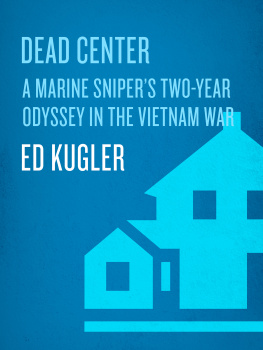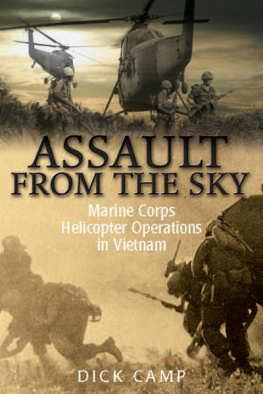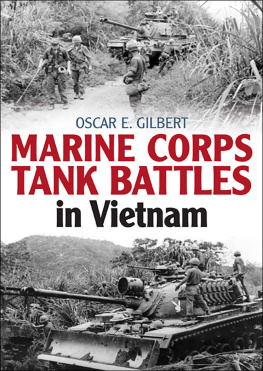

This edition is published by PICKLE PARTNERS PUBLISHING www.picklepartnerspublishing.com
To join our mailing list for new titles or for issues with our books
Or on Facebook
Text originally published in 1967 under the same title.
Pickle Partners Publishing 2013, all rights reserved. No part of this publication may be reproduced, stored in a retrieval system or transmitted by any means, electrical, mechanical or otherwise without the written permission of the copyright holder.
Publishers Note
Although in most cases we have retained the Authors original spelling and grammar to authentically reproduce the work of the Author and the original intent of such material, some additional notes and clarifications have been added for the modern readers benefit.
We have also made every effort to include all maps and illustrations of the original edition the limitations of formatting do not allow of including larger maps, we will upload as many of these maps as possible.
SMALL UNIT ACTION IN VIETNAM SUMMER 1966
By
Captain Francis J. West, Jr., USMCR
HISTORY AND MUSEUMS DIVISION HEADQUARTERS, U. S. MARINE CORPS WASHINGTON. D. C.,
Printed 1967 Reprinted 1977

TABLE OF CONTENTS
Contents
FOREWORD
The origin of this pamphlet lies in the continuing program at all levels of command to keep Marines informed of the ways of combat and civic action in Vietnam. Not limited in any way to set methods and means, this informational effort spreads across a wide variety of projects, all aimed at making the lessons learned in Vietnam available to the Marine who is fighting there and the Marine who is soon due to take his turn in combat.
Recognizing a need to inform the men who are the key to the success of Marine Corps operationsthe enlisted Marines and junior officers of combat and combat support unitsthe former Assistant Chief of Staff, G-3, Major General William R. Collins, originated a project to provide a timely series of short, factual narratives of small unit action, stories which would have lessons learned as an integral part. Essential to General Collins concept was the fact that the stories would have to be both highly readable and historically accurate. The basic requirement called for an author trained in the methodology of research, with recent active duty experience at the small unit level in the FMF, and a proven ability to write in a style that would ensure wide readership.
On the recommendation of retired Brigadier General Frederick P. Henderson, Captain Francis J. West, Jr., a Marine reserve officer, was invited to apply for assignment to active duty during the summer of 1966 to research and write the small unit action stories. Captain West was well qualified to undertake the project: he had recently been on active duty as a platoon leader in the Special Landing Force in the Western Pacific; he had majored in history as an undergraduate at Georgetown University and was a graduate student at the Woodrow Wilson School of Public and International Affairs at Princeton University; and he had written a number of articles, papers, and a book which indicated that he had the capability of communicating with a wide and varied audience.
Recalled to active duty at his own request late in May 1966, Captain West was given a series of informal briefings at Headquarters Marine Corps on the current situation in Vietnam and was soon on his way to that country. He arrived at Da Nang on 5 June and went into the field immediately as an observer/member of a wide variety of Marine small units and saw action in all parts of the III Marine Amphibious Force area of responsibility. Developing his own methods of operation, and carrying in addition to normal weapons and equipment, a tape recorder, a camera, and a note pad, the captain took part in most of the actions he describes and interviewed participants in the others immediately after the events portrayed. During his stay in Vietnam, Captain West was actively supported in his work by the Marines with whom he served, and by none more helpfully than the III MAF commander, Lieutenant General Lewis W. Walt, and his G-3, Colonel John R, Chaisson, who read and approved each of the rough draft narratives that Captain West completed in Vietnam. Colonel Thomas M. Fields, of the Combat Information Bureau at Da Nang also provided much assistance and support.
This pamphlet, then, is based upon first-hand, eyewitness accounting of the events described. It is documented by notes and taped interviews taken in the field and includes lessons learned from the mouths of the Marines who are currently fighting in Vietnam. It is published for the information of those men who are serving and who will serve in Vietnam, as well as for the use of other interested Americans so that they may better understand the demands of the Vietnam conflict on the individual Marine.

Major General, U. S. Marine Corps Assistant Chief of Staff, G-3
MINES AND MEN
Preface: The author spent two weeks with the 9th Marines, most of the time with Delta Company. He participated in the patrol described as an extra infantryman, swapping his tape recorder for an automatic rifle when the platoon was hit. Throughout most of the fight, he did not see the patrol leader, but later was able to piece together the entire action by interviews and by listening to his recorder, which was running throughout the engagement.
In late spring and early summer of 1966, the most notorious area in I Corps was the flat rice paddy-and-hedgerow complex around Hill 55, seven miles southwest of Da Nang. In the Indochina War, two battalions of the French forces were wiped out on Hill 55; in the Vietnam War, a Marine lieutenant colonel was killed on the same hill. The 9th Marines had the responsibility for clearing the area and no one envied the regimental commander, Colonel Edwin Simmons, and his men their job. The enemy they hated, the enemy they feared the most, the enemy they found hardest to combat, was not the VC; it was mines.
One company of the regimentDeltalost 10 KIA and 58 WIA in five weeks. Two men were hit by small arms fire, one by a grenade. Mines inflicted all the other casualties.
Only four of the wounded returned to duty. From a peak strength of 17 5, Delta Company dropped to 120 effectives.
Among those evacuated or killed were a high percentage of the companys leaders: five platoon commanders; three platoon sergeants; nine squad leaders; and six fire team leaders.
On 8 May, the 1st Platoon of Delta Company was 52 men strong, commanded by a first lieutenant and honchoed by a staff sergeant. For a month they patrolled. At division level, the operations section could see a pattern which indicated the patrols were slowly and surely rooting the VC infrastructure out of the area. But for the individual rifleman, it was ugly, unrewarding work, The VC in previous encounters had learned the futility of determined engagements against the Marines. So they sniped and ran and left behind the mines.
On 8 June, the 1st Platoon prepared to go out on another patrol. By then, they numbered 3 2 men and were commanded by a sergeant.
During patrols on the previous day there had been no casualties. Far from feeling encouraged, the troops were pessimistic, believing it inevitable that today another of their group would step on a mine.
Next page










